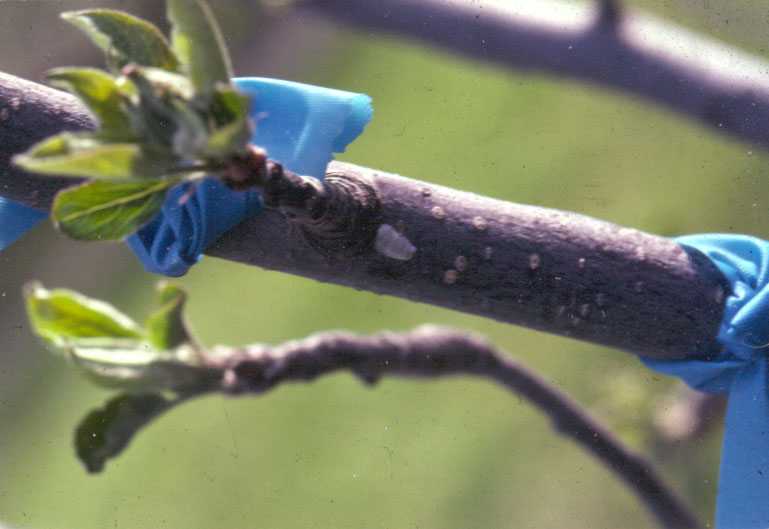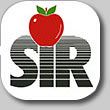Fruittree and European Leafrollers (Miscellaneous Pests)
General Description
Hosts
Fruit trees, berry crops, native and ornamental trees and shrubs, including hawthorn, poplar, willow, rose, locust, English walnut and box elder.
Damage
Buds - Small entry holes in buds, chewed petals and flower parts.
Blossoms - Petals webbed together, often remaining attached through petal fall; inner flower parts eaten.
Leaves - Chewed, rolled and tied together with silk.
Fruit - Deep irregular holes in small apples (Fig. 1,), creased surfaces in cherry (Fig. 2), and russeted scars in mature apples (Fig. 3).
.jpg) |
.jpg) |
|
| Figure 1. Fruittree or European leafroller feeding damage (H.Philip) | Figure 2. Cherries damaged by fruittree leafroller. | Figure 3. Russetted scars from earlier leafroller feeding. (BCMA) |
Identification
Egg - Flat masses of up to 150 tan to white eggs on small branches (Fig. 4).
 |
| Figure 4. Fruittree or European leafroller egg mass at base of spur. (H. Philip) |
Larva - Light to dark green body with black head; wriggles backwards and drops on silk thread when disturbed (Fig. 5).
.jpg) |
| Figure 5. Fruittree leafroller larva. (H. Philip) |
Adult - Fruittree leafroller moths are about 12 mm long, forewings bell-shaped when at rest, with a pattern of gold, tan and white markings. European leafroller moths are same size but with brown, bell-shaped forewings at rest with thin dark brown transverse lines.
Life History
These leafrollers are common pests in orchards in the Creston Valley and from Summerland north in the Okanagan Valley. They are becoming more common in the south Okanagan and Similkameen valleys. Overwintering egg masses begin to hatch at about the 15-mm green bud stage of McIntosh apple. Egg hatch may extend over several weeks under cool conditions. Also, eggs on south-facing sides of branches will hatch 4-5 days before eggs laid on the north side of branches. Newly hatched larvae release silken threads so they can float on the wind to disperse within the orchard and to host plants in adjacent properties. Larvae enter buds and feed on the flower parts, moving to leaves after bloom. They feed on leaves and developing fruit until mature. Pupation occurs within curled leaves. Adults emerge from June to August, mate and lay eggs that hatch the following spring. There is only one generation per year.
Monitoring
Inspect branches for egg masses during pruning. Mark at least 10 south-facing and 10 north-facing egg massess per orchard with surveyors tape and monitor for egg hatch weekly. A small dark hole will appear in hatched eggs. Select only eggs masses that do not have any dark spots. A degree-day (DD) model (base 5ºC from February 1) is available to determine the proportion of FTLR eggs hatched (e.g. 50% egg hatch at 154 DD; 100% at 250 DD). Alternatively, use limb taps and/or examine fruit bud and blossom clusters each week until young larvae are found. A pheromone-baited trapping system is available to monitor adult male fruittree leafroller, however no relationship exists between moth captures and subsequent larval abundance the following year.
Management
Biological Control
The Bt products Dipel 2X DF, Foray 48BA, Bioprotec CAF and Bioprotec Plus contain a toxic crystal produced by the bacterium Bacillus thuringiensis (Bt). The crystal is toxic once consumed by fruittree and European leafrollers and other caterpillars. The toxin makes holes in the gut lining allowing other bacteria to enter the ‘blood’ system of the caterpillars and slowly kill them. Infested caterpillars will stop feeding within hours and eventually die over the next 2 to 5 days. Caterpillars receiving a dose of Bt that does not kill them will resume feeding in about 7 days.
Best results are obtained when Bt is applied during blossom or petal-fall. Research and field reports indicate that mixing Bt products with ATS for application to apple during bloom does not affect the performance of either product. Because caterpillars must eat the Bt to be most effective, thorough coverage and correct timing are essential to ensure proper performance of Bt products. It is important that travel speed allow for sufficient displacement of air from the tree canopy to ensure thorough and uniform spray penetration and coverage. Where leafroller and green fruitworm numbers are low to moderate, a single application of Bt in late bloom has given good control. However, where larval numbers are high, apply a bloom spray followed by a second spray 7 days later.
Because Bt is sensitive to sunlight it is recommended that Bt products be applied in the very early morning or after 4:00 PM in the afternoon. Bt products can be applied during the day if partial or full cloud cover is present and there is no threat of rain for at least 24 hours. The optimum solution pH for Bt products is 6. Some breakdown occurs above that point and it is unstable above pH 8. To avoid possible degradation in the spray tank, apply the Bt immediately within 18 hours of mixing. Control is also improved if Bt is applied under warm (> 15C) temperatures.
Bt products are not toxic to bees or other beneficial insects and mites and are not phytotoxic. They are compatible with most insecticides and fungicides. Do not combine with highly alkaline materials such as Bordeaux mixture or lime-sulphur.
NOTE: Liquid formulations of Bt (Foray 48BA and Bioprotec CAF) should be used within 6 months of the date of manufacture (see product or package label).
Cultural Control
Pruning will remove many egg masses. Prune older, low-density trees to open up the canopy and improve spray penetration and coverage, especially into the upper canopy. Thinning fruit to singles where practical will help reduce the risk of fruit damage.
Chemical Control
Chemical - Many populations of Fruittree (FTLR) and European (ELR) leafrollers in the Okanagan Valley are resistant to the diazinon. These populations are also resistant to Confirm (NOTE: Intrepid is not registered for control of these leafroller species). Therefore, do not apply Confirm if OP products no longer provide satisfactory control of leafrollers in your orchard. Alternative products for protecting fruit where resistant populations occur are Exirel, Bt products (Dipel 2X DF, Foray 48BA, Bioprotec CAF or Bioprotec Plus), Success or Entrust. If your orchard has resistant species as well as non-resistant two-generation leafrollers, use a Bt product, Exirel, Success or Entrust rather than Confirm to ensure control of all leafrollers. Success and Entrust can harm earwigs and parasitic wasps exposed to direct sprays; however the threat is reduced once the residues dry.
Mating disruption – Apply Isomate-CM/LR TT in apples, pears and cherries at a rate of 750 dispensers/ha (300/acre). Double the rate along margins of orchards. Read the general instructions for using mating disruption under Codling Moth. It is important that leafroller population levels are very low within the orchard and there are no nearby outside sources of mated females (e.g. fruit trees, roses, raspberries, cottonwoods, chokecherry, alder, willow, dogwood, big-leaf maple, hawthorn, antelope bush, lupine). This control option also requires effective spring larval control. These product also provide mating disruption of any male obliquebanded leafroller, threelined leafroller and codling moths present in the treated orchard.
